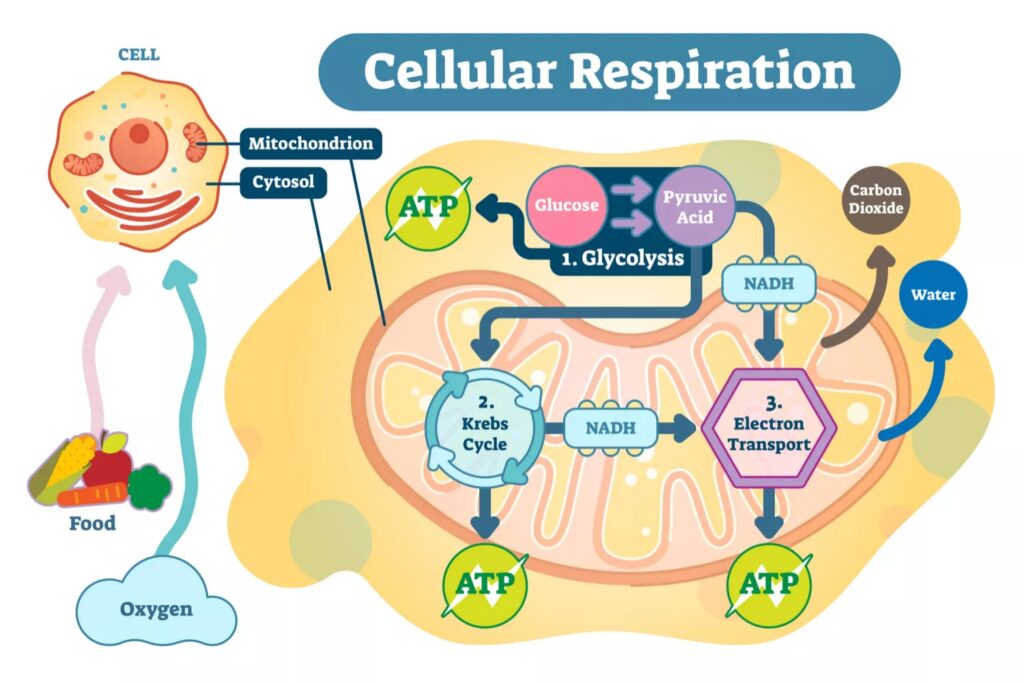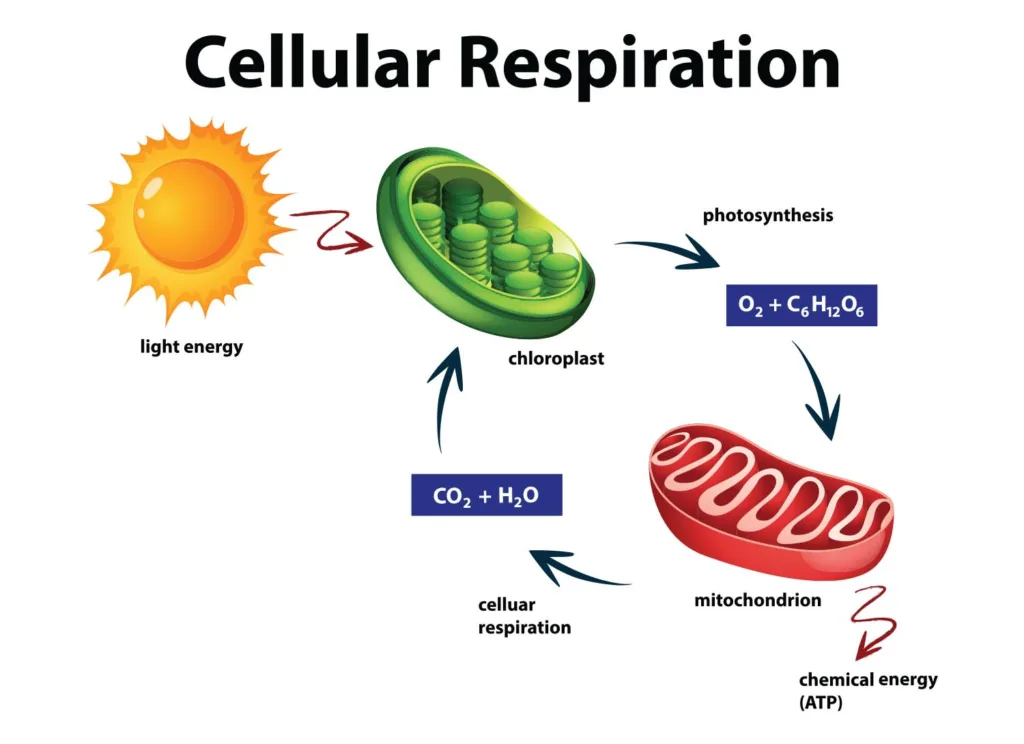Cellular respiration is a complex biochemical process that occurs in all living organisms. It involves the breakdown of glucose and other energy-rich compounds to produce ATP, the energy currency of cells. The process of cellular respiration can occur both aerobically, which requires oxygen, or anaerobically, which does not require oxygen.
In the initial stages of cellular respiration, glucose is broken down into pyruvate through the process of glycolysis. This process occurs in the cytoplasm of cells and does not require oxygen. The breakdown of glucose into pyruvate is a catabolic reaction, as it involves the breakdown of a complex biomolecular substance into simpler molecules.
After glycolysis, the pyruvate molecules enter the mitochondria, where they are further broken down in a process called the Krebs cycle. This process requires oxygen and is therefore an aerobic process. During the Krebs cycle, the energy stored in the pyruvate molecules is used to produce ATP. Carbon dioxide is released as a byproduct of the Krebs cycle.
The final stage of cellular respiration is the electron transport chain, which occurs in the inner membrane of the mitochondria. During this stage, the energy stored in the ATP molecules produced durng the Krebs cycle is used to generate a proton gradient across the inner membrane of the mitochondria. This gradient is then used to drive the synthesis of additional ATP molecules.
Cellular respiration is a catabolic process, as it involves the breakdown of complex biomolecular substances such as glucose to produce energy in the form of ATP. However, it is important to note that anabolic reactions also occur during cellular respiration. For example, the synthesis of ATP from ADP and inorganic phosphate is an anabolic reaction.
Cellular respiration is a complex process that involves both catabolic and anabolic reactions. The breakdown of glucose into pyruvate is a catabolic reaction, while the synthesis of ATP from ADP and inorganic phosphate is an anabolic reaction. This process is vital for the survival of all living organisms, as it provides energy for cellular processes.
The Catabolic Nature of Cellular Respiration
Cellular respiration is a metabolic process that occurs in all living cells. This process involves the breakdown of complex biomolecules such as glucose and other organic compounds to release energy for cellular activities. The energy released during cellular respiration is used to fuel biological processes such as muscle contractions, nerve impulses, and the synthesis of new biomolecules.
Cellular respiration is considered a catabolic process because it involves the breakdown of complex biomolecules into simpler compounds. The initial breakdown of glucose occurs in the cytoplasm, where it is converted to pyruvate throgh a process called glycolysis. Pyruvate molecules are then broken down in the mitochondria through a series of reactions called the citric acid cycle and the electron transport chain.
During these reactions, energy is released in the form of ATP, which is used by the cell to perform various biological functions. The breakdown of glucose and other organic molecules releases electrons, which are transferred to electron carriers such as NAD+ and FADH2. These carriers then transport the electrons to the electron transport chain, where they are used to generate a proton gradient across the inner mitochondrial membrane. The energy released by this gradient is harnessed to produce ATP.
Cellular respiration is a catabolic process because it involves the breakdown of complex biomolecules into simpler compounds, releasing energy that is used by the cell to perform biological functions. This process is critical for the survival of all living organisms, as it provides the necessary energy for cellular activities.

Is Cellular Respiration Anabolic or Catabolic?
Cellular respiration is a catabolic pathway, meaning it involves the breakdown of complex molecules into simpler ones, resulting in the release of energy. This energy is then used to produce ATP, which is the primary energy currency for cells. During cellular respiration, glucose and other energy-rich compounds are broken down thrugh a series of chemical reactions, leading to the production of ATP. This process can occur both aerobically, in the presence of oxygen, and anaerobically, in the absence of oxygen. However, aerobic respiration is much more efficient in terms of ATP production. cellular respiration is a catabolic process that produces ATP by breaking down energy-rich compounds.
Anabolic or Anaerobic: The Nature of Cellular Respiration
Cellular respiration is a metabolic process that occurs in both aerobic and anaerobic conditions. However, the type of respiration differs depending on the availability of oxygen. Anaerobic respiration occurs in the absence of oxygen, while aerobic respiration occurs in the presence of oxygen.
Anabolic reactions involve the synthesis of complex molecules from simple ones, which requires energy input. On the oher hand, catabolic reactions break down complex molecules into simpler ones, releasing energy. Cellular respiration is a catabolic process that involves the breakdown of glucose into simpler molecules, such as ATP, which releases energy.
Therefore, cellular respiration is not an anabolic process. Instead, it is a catabolic process that releases energy for the anabolic processes to occur. The energy released during cellular respiration is used to fuel anabolic reactions, which build complex molecules from simpler ones.
Cellular respiration is a catabolic process that releases energy, which is then used to fuel anabolic reactions.
The Anabolic or Aerobic Nature of Cellular Respiration
Cellular respiration is primarily considered an aerobic process, meaning that it requires the presence of oxygen to occur. It involves the breakdown of glucose molecules into ATP, which can be used by the cell for energy. This process occurs in the mitochondria of the cell and is divided into three main stages: glycolysis, the Krebs cycle, and the electron transport chain.
During glycolysis, glucose is broken down into two molecules of pyruvate, which are then transported into the mitochondria. In the Krebs cycle, thse molecules are further broken down to produce ATP, carbon dioxide, and water. the electron transport chain uses the energy produced during the Krebs cycle to create a proton gradient, which is used to drive the production of additional ATP molecules.
While cellular respiration is primarily an aerobic process, it can also occur anaerobically under certain conditions. In anaerobic respiration, glucose is broken down into ATP without the use of oxygen. This process is less efficient than aerobic respiration and results in the production of lactic acid or ethanol as byproducts.
Cellular respiration is primarily an aerobic process that involves the breakdown of glucose molecules into ATP, carbon dioxide, and water. However, it can also occur anaerobically in the absence of oxygen.

Conclusion
Cellular respiration is a complex process that involves the breakdown of glucose into energy-rich compounds such as ATP. This process is essential for the survival of living organisms as it provides the necessary energy for carrying out life processes. The two types of cellular respiration, aerobic and anaerobic, differ in teir requirement for oxygen. Aerobic respiration is more efficient and produces more ATP, while anaerobic respiration is less efficient and produces lactic acid or ethanol as byproducts.
Cellular respiration is a vital metabolic process that plays a crucial role in the functioning of living organisms. It is a catabolic reaction that breaks down complex biomolecules to release energy, which is used to carry out various cellular processes. Understanding cellular respiration is essential for scientists to develop new treatments for diseases and to improve the efficiency of various industrial processes.
